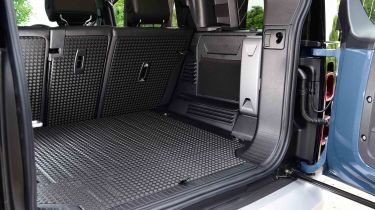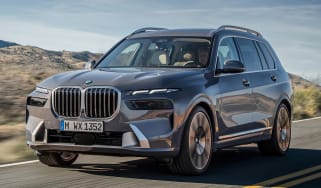Land Rover Defender - Boot space, comfort & practicality
The Defender scores well for practicality and comfort. Overall versatility is deeply impressive too.

The Land Rover Defender is brilliantly practical, with basics such as the useful central storage bin and deep door pockets, while even a fridge can be fitted under the centre armrest of some models. There’s also the usual generous supply of cup-holders, power outlets and air vents around the cabin. All versions besides the S get full electric front seat controls with memory settings, so you can easily find the most comfortable position.
The boxy proportions of the Defender mean it's easy to see the corners of the car and judge where to place it on the road, but all models come with an advanced 360-degree 3D surround camera – something you have to pay extra for on a BMW X5 – for a little extra help when parking. There are also clever touches to help you with towing, with the on-board cameras assisting you in lining up a trailer, while the air suspension can raise and lower to make hitching up easier.
The ClearSight system is another handy addition for Defender drivers and comes with Mirror or Ground functions. The rear-view mirror can be used normally, but is also able to display a rear-facing camera feed when either rear passengers or a tall item in the boot is blocking your view through the rear window. The central touchscreen can be used to relay footage from the numerous cameras on the outside of the car, so you can see what's beneath and just in front of the vehicle – invaluable when off-roading.
Used - available now

2024 Land Rover
Defender
14,226 milesAutomaticPetrol2.0L
Cash £75,695
2024 Land Rover
Defender
17,500 milesAutomaticDiesel3.0L
Cash £59,995
2020 Land Rover
Defender
41,850 milesAutomaticDiesel2.0L
Cash £45,195
2020 Land Rover
Defender
18,157 milesAutomaticDiesel2.0L
Cash £49,695In 2024, the Defender 130 gained the option of the Captain’s Chairs Pack, which adds two individual seats in the second row for “ultimate comfort, spaciousness and versatility”, according to Land Rover. You can still access the third row, with an aisle between them. The middle-row Captain’s Chairs feature heating and cooling functions with new headrests, armrests and cup-holders.
| Dimensions | |
| Length | 4,583mm (90), 5,018mm (110), 5,358mm (130) |
| Width | 2,008mm (2,105mm inc. mirrors) |
| Height | 1,974mm (90), 1,967mm (110), 1,970mm (130) |
| Number of seats | Five |
| Boot space | 297-1,263 litres (90), 786-1,875 litres (110 wi. 5 seats), 1,094-2,078 litres (130) |
Dimensions and size
Given the focus on off-road ability and ground clearance of up to 294mm, it’s no surprise that the Defender feels like a big car – inside and out. On coil suspension, the Defender 90 measures 1,974mm tall, compared with 1,969mm when fitted with air suspension. The overall length of the three-door (spare wheel included) is 4,853mm – longer than a Nissan Qashqai. It’s also a fairly chunky 2,008mm wide.
The five-door variant is unsurprisingly longer at 5,018mm, although overall width is the same as its smaller sibling. The even longer Defender 130 measures 5,358mm in length – more than 10cm longer than the flagship Range Rover luxury SUV and far longer than a Mercedes G-Class.
How practical is the Land Rover Defender?
Seats & space in the front
There’s plenty of room up front in the cabin of every Defender, although rear cabin space varies depending on the model you get. While overhead windows mean a lot of natural light, there’s very little space in the rear of the Defender 90, and because it's only a three-door, access to the back seats isn’t the easiest. The front seats fold and slide forward, but it feels like a mountain climbing expedition every time you have to haul yourself aboard.
Seats & space in the back
As you'd expect, there's much more room in the back seats of the Defender 110, which are also easier to access thanks to the additional doors. If you want, you can specify an extra seat between the driver and front passenger in the 110 model to make it a six-seater, or add a further two seats in the boot to make it a seven-seater – strangely, you can’t combine the two options to make yourself an eight-seater. If you do get the seven-seater 110, the second row comes with a sliding function, so you can give taller passengers in the third row a bit more legroom.
The Defender 130 puts most MPVs to shame, with its extra length allowing for two rows of three seats behind the driver and front passenger seat, for a total of eight occupants. These are arranged with a slight ‘stadium-style’ increase in height for a good view out, and there’s even a second sunroof above the third row.
Every version comes with ISOFIX child seat tethering points on the outermost positions of the second row.
Boot space
The three-door Defender 90 has a 297-litre boot, which is actually smaller than a Vauxhall Corsa and much smaller than the 356 litres of space provided behind the third row of a Volvo XC90. If you need to carry longer items, dropping the rear seats gives you 1,263 litres to play with.
The Defender 110 offers a more generous amount of boot space, which should be enough for most families. If you get the five-seater 110, there's 786 litres of space on offer behind the rear seats, and 1,875 litres with them down. Plug-in hybrid versions of the 110 offer slightly less luggage capacity because of the battery located under the boot floor, reducing the available boot space to 696 litres with all five seats in place and 1,759 litres with the rear seats folded away.
Opt for the seven-seater version of the 110 and there's 160 litres with all three rows of seats in place, 743 litres with two rows in the upright position and the same 1,875 litres with all but the front seats stowed in the floor.
The eight-seater Defender 130’s boot isn't that much bigger. There's 290 litres of space available even with all eight seats in place, and if you fold the second and third rows down there’s close to 1,900 litres on offer. For those who prioritise luggage capacity, a five-seat 130 is also available, boosting ultimate boot space even further to nearly 2,100 litres.
The Defender uses a side-opening tailgate, which has its positives and negatives. You’ll have to be a bit more wary in tight car parks with the big spare wheel bolted to the outside. However, if you’re tall and clumsy, you’ll never have to worry about banging your head when loading up.
Towing
Most versions of the Defender have a maximum towing limit of 3,500kg, although the plug-in hybrids and heavy Defender 130 have a reduced braked trailer towing rating of 3,000kg. In either case, that’s a lot more than the 2,700kg capacity of the best-performing plug-in hybrid BMW X5 xDrive50e.
The Towing Pack includes an electrically deployable tow bar, and the 13-pin electric point is located within easy reach. You can also add an Advanced Tow Assist function where you can use the rotary dial from the Terrain Response system to steer the vehicle in reverse. Pull the dial up while reversing, and you can steer the car and caravan/trailer using the moving directional arrows on the screen, which show where the car will go. We think that’ll be helpful for those who struggle with this task.








